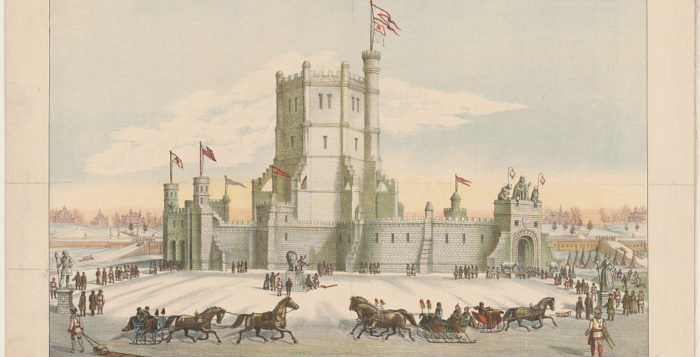This Day in Hockey History – January 24, 1896 – St. Paul’s Beginnings
(Photo: Winter Carnival 1887, via Wikimedia Commons)
Many who live outside the “State of Hockey” do not realize that the Twin Cities can be quite different from each other. Minneapolis actually had ice hockey for almost a year before St. Paul caught up by forming the St. Paul Hockey Club in December 1895. It wasn’t until Aurora Park opened on New Year’s Day that St. Paul hosted its first games. During the Winter Carnival on January 24 and 25, 1896, St. Paul held its first tournament, matching two of its own teams against teams from Minneapolis and Winnipeg.
“Hockey is claimed by its admirers to be the fastest and most exciting ice game played in this country,” gushed the St. Paul Globe in mid-December 1895. The St. Paul Hockey Club had just organized, and its membership had already grown from 22 to somewhere in the range of 40-50. That group would supply the teams who would play in games and tournaments. With so many members, they thought they might even put together six whole teams for the upcoming Winter Carnival tournament.
The club chose to have members each wear a “cap of crimson and gold colors.” Other than that, they “opposed to the adoption of a uniform, owing to the fact that several members of the club are already members of other carnival clubs which have uniforms.”
Their first practice was scheduled for Como Park on December 15 at 10:30 am. Once Aurora Park opened, the St. Paul Hockey Club members would pay $2.50 for the right to play there once a week (since the four polo clubs already had agreements there). As the Globe explained, “This insures the permanency of the membership, as each one putting up for a ticket will be sure to continue his connection.”
Aurora Park would feature at least three skating surfaces. The 300×215-foot rink was meant for pleasuring skating, and the 10-foot track outside would host speed skating. “In front of the grand stand will be the Polo rink, 170×150 feet, where polo and hockey will be played,” reported the Globe. There would be a 24×100-foot warming house with refreshments located on the Dale Street side, and Fort Karnival would be erected in the park on St. Alban’s Street. All of Aurora Park would have electric lighting.
The park delayed its opening due to mild weather, wanting to wait for “first-class ice.” The grand opening was held on January 1. They offered music, a polo game, and hockey in the afternoon and evening, followed by fireworks. “The crowd increased in the evening,” noted the Globe. “The rink was illuminated with clusters of electric lights, supported on masts, and by colored pyrotechnic displays”
The following day, a “spirited game of ‘hockey’ was held between two teams made up of the St. Paul Hockey Club. They played despite other events being postponed due to excessive cold. Some visitors came out to skate, and the warming house was opened up for a dance.
Finally, the Winter Carnival tournament took place. Only four teams ended up participating with half consisting of members from the St. Paul club. Unfortunately for these newcomers, the first two games, held at Aurora Park on January 24, “resulted in a bad defeat for teams one and two of the St. Paul club.” During the afternoon game, Winnipeg crushed Team 1 with a score of 13-2. “From the manner in which they played, the Winnipeg club will undoubtedly carry home the trophies,” predicted the Globe. “They have a great advantage over the St. Paul players in team work, although individually the kind of game put up by them is not much superior.” That evening, Minneapolis beat Team 2 by 4-1 before a large number of carnival spectators.
On January 25, the consolation and championship games were held next to the curling rinks, and “the playing was of the genuine sort there.” Happily, the afternoon had “carnival weather of the right sort, and its effects were visible at the fort and Aurora park, both in the way of attendance and in enjoyment.” In two 15-minute halves, Winnipeg proved the Globe correct by winning first prize over Minneapolis with a score of 7-2. Again the Globe recognized their superiority, praising Winnipeg’s “much greater skill and endurance,” but the press also noted that the “Minneapolitans fought vigorously.” For prizes, Winnipeg won a silver stein and Minneapolis took home hockey sticks.
It would not be until 1902 that the area hockey teams formed a formal league. When they did, the Twin City Hockey League included St. Paul Hockey Club, Mechanics Arts High School, the Mascots, the Virginias, and Minneapolis. Beginning in 1904, their champion would play either Two Harbors or Duluth for the title of state senior champion. Meanwhile, after 1896, the Winter Carnival would not return until 1916 and 1917.
Additional Sources:
- “Aurora Skating Rink” and “Hockey Club Formed,” Saint Paul Globe, 15 Dec. 1895, p. 14.
- “Hockey in Favor,” Saint Paul Globe, 22 Dec. 1895, p. 7.
- “Aurora Skating Rinks,” Saint Paul Globe, 31 Dec. 1895, p. 5.
- “Aurora Rink Open,” Saint Paul Globe, 2 Jan. 1896, p. 5.
- “Aurora Rink Opening,” Saint Paul Globe, 3 Jan. 1896, p. 5.
- “St. Paul Beaten,” Saint Paul Globe, 25 Jan. 1896, p. 5.
- “No Doubt of it Now and “Seven to Two,” Saint Paul Globe, 26 Jan. 1896, pp. 1-2.
- Stephen Hardy and Andrew C. Holman, Hockey: A Global History (University of Illinois Press, 2018), kindle edition.














